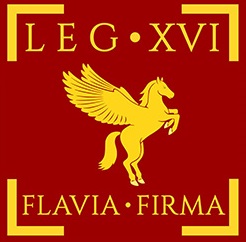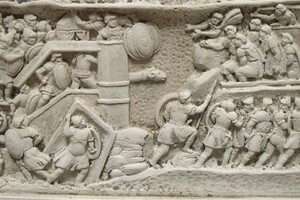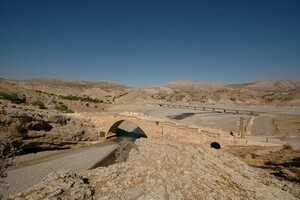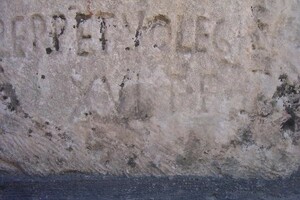Roman Legion - Legio XVI Flavia Firma
The Legio XVI Flavia Firma (Sixteenth Steadfast Flavian Legion) was a Roman legion formed in AD 70 by Emperor Vespasian from former legionnaires of Legio XVI Gallica, who had disgraced themselves during the Batavian rebellion of AD 69-70.
Dates of existence: AD 70 – early 5th century AD.
Emblem: Initially a lion, later changed to Pegasus.
Nickname: Flavia Firma (Steadfast Flavian), Severi (Severan), Flavia Fidelis (Flavian Faithful).

Battle Path
- Legio XVI Flavia Firma was created in AD 70 by Emperor Vespasian (reigned 69-79 AD) from the former legionnaires of Legio XVI Gallica, who had disgraced themselves during the Batavian rebellion of AD 69-70. Legio XVI Flavia Firma was immediately sent to the eastern provinces, as most of the legionnaires were originally from western Gaul.
- In the East, Legio XVI Flavia Firma was stationed with Legio XII Fulminata at Satala (modern Sadak, Armenia) in the upper Euphrates region in the northeastern part of Cappadocia (modern Turkey), on the border with Armenia (a buffer state between the Roman and Parthian empires at that time).
- In AD 75, a detachment of Legio XVI Flavia Firma, along with detachments from three other legions, was involved in the construction of a canal and bridge in Antioch (modern Antakya, Turkey).
- In AD 114-117, Legio XVI Flavia Firma participated in Emperor Trajan's Parthian campaign.
- Emperor Hadrian (reigned 117-138 AD) relocated Legio XVI Flavia Firma from Satala to Samosata (an ancient city on the western bank of the Euphrates. The ruins of Samosata are now near the modern Turkish city of Samsat and are submerged following the construction of the Ataturk Dam). Here, the legionaries of Legio XVI Flavia Firma mainly engaged in construction work, as the region was quiet and peaceful. For example, soldiers built a tunnel near Seleucia Pieria (the ruins of an ancient city in Syria, near the modern Orontes River, Syria).
- A detachment of Legio XVI Flavia Firma participated in suppressing the Bar-Kokhba rebellion in Judea from AD 132-135.
- Emperor Antoninus Pius (reigned 138-161 AD) awarded Legio XVI Flavia Firma the title "Flavia Fidelis" (Flavian Faithful). At that time, a detachment of Legio XVI Flavia Firma was stationed near Seleucia Pieria (the ruins of an ancient city in Syria, near the modern Orontes River, Syria).
- In AD 161, the Parthians defeated the Roman army in Cappadocia. In response, Roman Emperor Lucius Verus launched the Parthian campaign of AD 162-166, in which Legio XVI Flavia Firma participated.
- In AD 194 and 197-198, Legio XVI Flavia Firma participated in the two Parthian campaigns of Emperor Septimius Severus (reigned 193-211 AD), which ended with the capture of the Parthian capital, Ctesiphon (ruins located 32 km from modern Baghdad, Iraq), and the creation of a new Roman province called Mesopotamia.
- Legio XVI Flavia Firma also participated in Emperor Caracalla's (reigned 211-217 AD) Parthian campaign in AD 216-217.
- During the reign of the Severan dynasty (reigned 193-235 AD), Legio XVI Flavia Firma received the nickname "Severi" (of the Severans). During this time, the legionaries of Legio XVI Flavia Firma built a bridge over the Chabinas River, modern Sendere Suyu. This bridge is still in use and leads to the mountain sanctuary of Nemrud-Dagh.
- Around AD 210, a detachment of Legio XVI Flavia Firma and Legio IIII Scythica, under the joint command of centurion Antonius Valentinus, were stationed at the fortress of Dura-Europos (an ancient city on the Euphrates), where they were repairing the Mithras sanctuary.
- It is likely that Legio XVI Flavia Firma participated in Emperor Alexander Severus' (reigned 222-235 AD) campaign against the Sassanid Empire, the successor of the Parthian kingdom, in AD 231-232. The war with the Sassanids in the east continued with varying success for both sides. Eventually, the Romans lost the province of Mesopotamia, and in AD 260, Roman Emperor Valerian I (reigned 253-260 AD) was defeated and captured by the Sassanids. These Roman defeats are marked on several Sassanid monuments. However, Emperor Odaenathus of Palmyra (reigned 261-267 AD) and Roman Emperor Diocletian (reigned 284-305 AD) managed to inflict several defeats on the Sassanids. In AD 298, peace was concluded between the Sassanids and the Roman Empire, returning territories in northern Mesopotamia to the Romans. It is presumed that the legionaries of Legio XVI Flavia Firma played a significant role in these events, although we have little information about it.
- In the 4th century, Legio XVI Flavia Firma was still stationed on the eastern frontier, guarding the Euphrates, but was relocated to Sura, further downstream from its old base at Samosata.
- According to the Notitia Dignitatum, at the beginning of the 5th century, Legio XVI Flavia Firma was under the command of the Dux of Syria and was stationed with its prefect in Sura, part of the province of Augusta Euphratesia (a Roman province formed in the 4th century in the territory of Coele-Syria, along the western bank of the Euphrates River).
Related topics
List of Roman Legions, Legion, Legionnaire, Legio XVI Gallica, Diocletian, Notification Dignitatum
Literature
1. Emil Ritterling. Paulys Realencyclopädie der classischen Altertumswissenschaft. Legio (XVI Flavia). Band XII,2. — Stuttgart, 1925. — 1765—1768 p.
2. Oliver Stoll. Römisches Heer und Gesellschaft. — Stuttgart: Steiner, 2001.
3. Axel Gebhardt. Imperiale Politik und provinziale Entwicklung. — Berlin: Akademie-Verlag, 2002.
4. Peter Edwell. Between Rome and Persia. The middle Euphrates, Mesopotamia and Palmyra under Roman control. — London: Routledge, 2008.
5. R. Cagnat. A Brief History of Various Legions.
6. Stephen Dando-Collins. "Legions of Rome: The Complete History of Every Imperial Roman Legion." Moscow: Centerpoligraf Publishing House, 2017.





